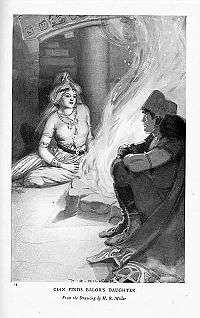Ethniu

In Irish mythology, Ethniu (Old Irish pronunciation: [ˈeθʲnʲu]), or Eithne (Irish pronunciation: [ˈehnʲə]) in modern spelling, is the daughter of the Fomorian leader Balor, and the mother of Lugh. She is also referred to as Ethliu (modern Eithle), genitive Eithlionn (modern Eithleann), dative Ethlinn (modern Eithlinn).
Her union with Lugh's father, Cian of the Tuatha Dé Danann, is presented in early texts as a simple dynastic marriage,[1] but later folklore preserves a more involved tale, similar to the birth of Perseus in Greek mythology. A folktale recorded John O'Donovan in 1835 tells how Balor, in an attempt to avoid a druid's prophecy that he will be killed by his own grandson, imprisons Ethniu in a tower on Tory Island away from all contact with men. But a man called Mac Cinnfhaelaidh, whose magical cow Balor stole, gains access to Ethniu's tower, with the magical help of the leanan sídhe Biróg and seduces her. Ethniu gives birth to triplets, but Balor gathers them up in a sheet and sends a messenger to drown them in a whirlpool. The messenger drowns two of the babies, but unwittingly drops one in the harbour, where he is rescued by Biróg. She takes the child back to his father, who gives him to his brother, Gavida the smith, in fosterage. The boy grows up to kill Balor.[2] By comparison with texts like Cath Maige Tuired and the Lebor Gabála Érenn, the unnamed boy is evidently Lugh, and his father, Mac Cinnfhaelaidh, is a stand-in for Cian.[3]The Banshenchus states that her real name was Feada- "Feada was the real name of noble Ethne who was wife of strong stout Cain, and mother of Lug the impetuous superman, and daughter of swift smiting Balor son of Dod son of mighty Net a greater man than pleasant Hector. From him is famed the cairn at Ath Feindead because he fought a duel."[4]
In some traditions she is the daughter of Delbáeth, the mother of the Dagda and Ogma, and the wife of Nuada Airgetlám. In a variant version of the birth of Aengus, she is the wife of Elcmar who is seduced by the Dagda: as such she may be a double of Boann, who plays that role in the best-known version of the tale.[5] Although in most texts she is a female figure, there are some in which Ethniu is a male name. In the ancient text Baile in Scáil ("The Phantom's Ecstatic Vision"), Lugh is said to the son of "Ethliu son of Tigernmas", or the son of "Ethniu son of Smretha son of Tigernmas". James Bonwick[6] identifies Tigernmas, the king who introduced the worship of Crom Cruach, with Balor. R. A. Stewart Macalister also suggests that Cethlenn is originally a variant of Ethlenn arising from the frequent identification of Lugh as Lugh Mac Ethlenn (thus Mac Ethlenn → Mac Cethlenn).[7]
Ethniu is a fine example of the difficulty of conducting research into Irish mythology. Her oldest version of her name is probably Ethliu or Ethniu, giving rise to the modern Irish name Eithne. However thanks to changes in the Irish language, the lack of standardised spelling for many centuries, and attempts to anglicise the name, variations have arisen. Linguistic ignorance has further confused the issue: the genitive form of Ethniu is Ethnenn (modern Eithneann) and the genitive of Ethliu is Ethlenn/Ethlinn (modern Eithleann/Eithlinn), as in mac Ethlenn ("Ethliu's son"). This genitive has often been taken for a nominative, or a mistaken nominative has been inferred.
Variations and anglicizations include: Ethnea, Eithliu, Ethlend, Ethnen, Ethlenn, Ethnenn, Ethne, Aithne, Enya, Lily, Aine, Ena, Etney, Eithnenn, Eithlenn, Eithna, Ethni, Edlend, Edlenn.
References
- ↑ Whitley Stokes (ed. & trans), "The Second Battle of Moytura", Revue Celtique 12, 1891, p. 59
- ↑ John O'Donovan (ed. & trans.), Annala Rioghachta Éireann: Annals of the Kingdom of Ireland by the Four Masters Vol. 1, 1856, pp. 18–21, footnote S
- ↑ T. W. Rolleston, Myths and Legends of the Celtic Race, 1911, pp. 109–112; Augusta, Lady Gregory, Gods and Fighting Men, 1094, pp. 27–29
- ↑ http://www.maryjones.us/ctexts/banshenchus.html
- ↑ James MacKillop, Dictionary of Celtic Mythology, 1998, p. 155
- ↑ James Bonwick, Irish Druids and Old Irish Religions, 1894
- ↑ R. A. Stewart Macalister (ed. & trans.), Lebor Gabála Érenn Vol. 4